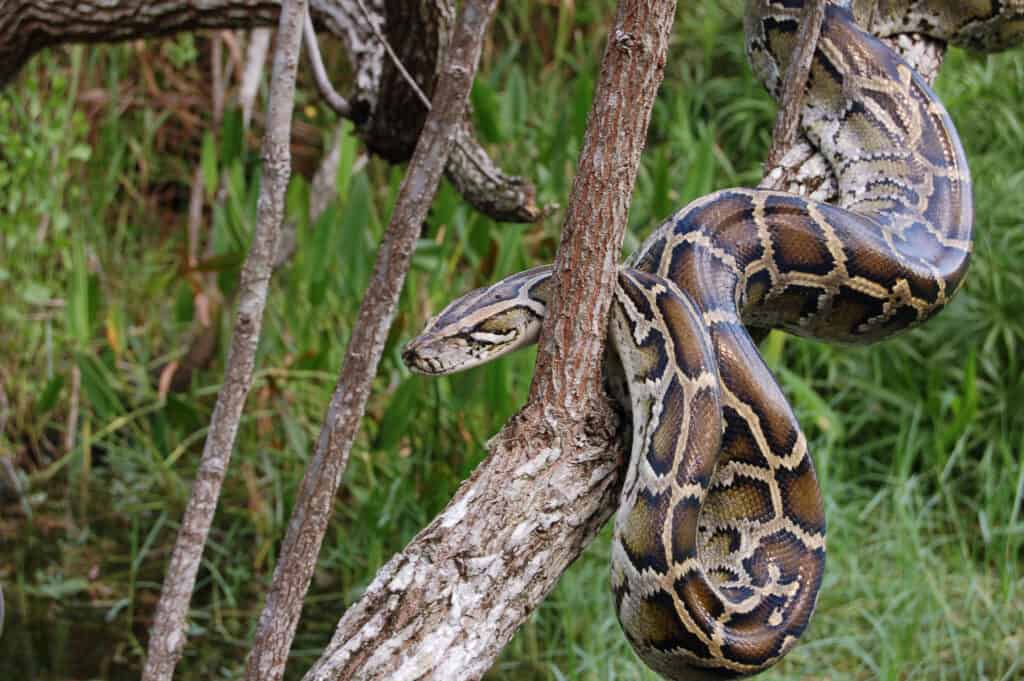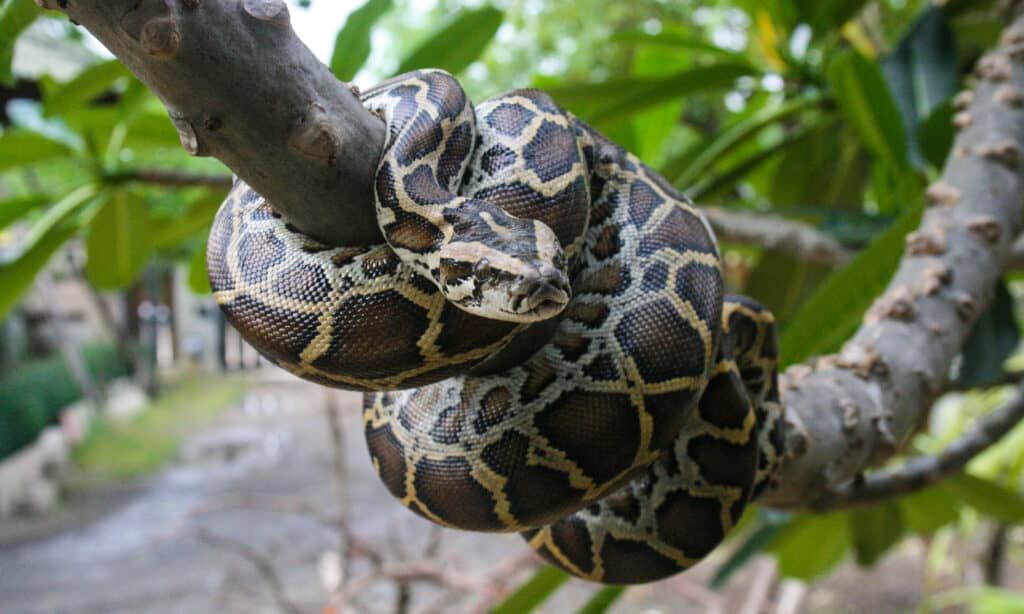Florida Burmese Pythons Are Still an Ongoing Threat, Just Not Directly to Humans

The Burmese python is a species invasive in the Everglades; a gigantic, mostly wetlands ecosystem in Southern Florida.
©Heiko Kiera/Shutterstock.com
Florida Burmese pythons are still a significant but indirect threat to Florida and Floridians. Like trucks that move and deliver most of the food supply in the U.S., the truck isn’t what feeds us. In much the same way, the Burmese python crisis in Florida isn’t a direct threat to people. There aren’t any deaths confirmed by a Burmese python in Florida. But these linebacker-sized serpents create problems for water, plants, and—of course—swamps in Florida. They disrupt the land and the ecosystems of Florida people.
Putting a Number on the Florida Burmese Pythons is Hard
For several reasons, this non-native species is very hard to find and count. Most sources say there are, at minimum, tens of thousands of invasive Burmese pythons in Southern and south-central Florida. Some estimate there are, as of 2024, a quarter-million of the beasts in the Sunshine State.
But They Are Getting Bigger, Suggesting They’ve Adapted Well to Florida

A college student from Ohio killed a 19-foot 0-inch Burmese python in Florida in July of 2024. It was probably the world’s largest discovered specimen.
©asawinimages/Shutterstock.com
The Guinness Book of World Records lists a now deceased female Burmese python at zoo safari as the longest ever, measuring in at 18 feet 10 inches. But their entry is listed as November 2016. Somebody found a bigger one in July of 2024 at Cypress National Reserve in Collier County, Florida. Jake Waleri, a student at The Ohio State University, wrangled off a 19-foot 0-inch long specimen.
We may be looking at the longest-ever Burmese python on earth, having originated from Florida.
Centuplets? For Snakes in South Florida, It’s Possible

A mature female Burmese python can lay up to 100 eggs per year! And those eggs are almost twice the size of a standard chicken egg.
©Paul Tessier/Shutterstock.com
This successful capturing and dispatching of a 125-pound snake was notable in another way regarding the persistent problem of these snakes in Florida. When necropsied, biologists suspected she’d probably just laid 100 eggs. Another sixteen-foot gestating female was caught and dissected the same month. The hunter shared a grisly photo of dozens of tennis-ball-sized eggs laid out on a table.
The fact that a female of the species can birth such an impressive clutch suggests exponential growth in each new generation. According to Live Science, a 2016 study determined that Burmese pythons had 77% “hatching success,” indicating a high survival rate.
Dog (and Human) the Bounty Hunters

Squeaky toys appeal to dogs’ hunting instinct because the squeak reminds them of the sounds of prey being captured. Florida has used dogs to track and hunt the invasive Burmese pythons and has now enlisted humans.
©GoodFocused/Shutterstock.com
Florida Wildlife Management had originally tried canine tracking of the invasive pythons. But the state has had such a hassle with the snakes they’ve recruited citizens to sign up as designated python hunters. Hunters are given a small hourly wage and $50 for each smaller Burmese python caught. Each snake over four feet in length has a $25-per-foot bonus. If paid out as advertised, this means that Waleri could have earned $425 minimum for his 19-foot behemoth.
The story of these rugged, for-hire expeditionists has made international news.
Danger from the Florida Burmese Python’s Amazing Ability to Survive

Presently, Burmese pythons are an invasive species in the state of Florida. They eat almost anything, live for 25 years, and have tons of offspring making them very hard to get rid of.
©Irina oxilixo Danilova/Shutterstock.com
According to Phillips Park Zoo in Aurora, IL, Burmese pythons can live for 25 years. This long life span means that the original batch of Florida escapees—believed to have been, in part, from a breeding facility smashed up by Hurricane Andrew in 1992—only died within the last few calendar years. Additionally, that means thousands of adult Burmese pythons born in the previous century are still slithering around Everglades National Park.
“All they do is eat and destroy . . . they are the teenage males of the ecosystem”
This comes from Dave Barry in his writings on the invasive pythons. The Pulitzer Prize-winning columnist and author is famous for writing about his zany adopted home state of Florida.
He makes the point here that Burmese pythons are not picky eaters. They will eat virtually anything. They’re not too picky about portions either, as another unfortunate reptile found out. An enormous python arrived at a lab in Florida looking rather unsnake-like with a giant bulge in its mid-section. Upon dissection, the biologists found and extracted the cause: a five-foot-long alligator.
Dissected pythons have yielded the consumed remains of 37 different types of birds. Ian Bartoszek, a wildlife biologist with the Conservancy of Southwest Florida, notes his experience seeing a python try to swallow a young deer that weighed more than the snake itself.
Hide and Seek
Swamps are notably tricky places to find anything. And when a mysterious, semi-aquatic snake has over 2,400 square miles of the Everglades to hide in, that’s a tough game of hide and seek.
Burmese Pythons in Florida Are Still Enough of a Problem for Conservationists to Get Very Creative
It’s apparently enough of a problem that conservationist Mike Kimmel, aka “Python Cowboy,” has been leading efforts to disrupt the Burmese pythons’ mating. As well, USGS is using various radio-frequency trackers and other technology to encourage the birth of only male snakes to prevent the generous clutches produced by females each year.
New Findings

Burmese pythons are among the largest snakes on Earth. Research by the journal
Animal Biotelemetrysuggests the Florida Everglades invasive pythons spend more than three-fourths of their time at rest.
©iStock.com/Lunatic_67
Research published in the journal Animal Biotelemetry might suggest Burmese pythons are surprisingly sedentary. They only chipped a handful of specimens, but they found that the snakes spent 86% of their time at rest!
However, the same research found that when they move, they move. The average time for a single jaunt was over ten hours. One snake was recorded moving continuously for 58 and a half hours straight!
The Threat, Indirectly, Continues
It’s almost impossible—outside of hunting them—to be directly injured or killed by Burmese pythons in Florida. However, if and until it becomes a direct threat to humans, it’s a matter of quantity and not quality. But when it comes to surviving, these Burmese pythons have both.
The photo featured at the top of this post is © Heiko Kiera/Shutterstock.com
Discover the "Monster" Snake 5X Bigger than an Anaconda
Every day A-Z Animals sends out some of the most incredible facts in the world from our free newsletter. Want to discover the 10 most beautiful snakes in the world, a "snake island" where you're never more than 3 feet from danger, or a "monster" snake 5X larger than an anaconda? Then sign up right now and you'll start receiving our daily newsletter absolutely free.
Thank you for reading! Have some feedback for us? Contact the AZ Animals editorial team.







